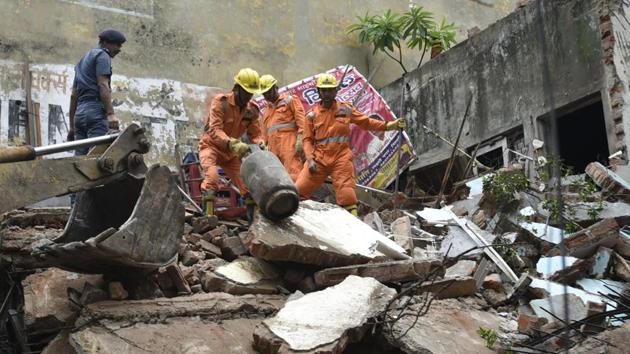Delhi building collapse: No lessons learnt from 2010 Lalita Park disaster
A four-storey building collapsed in east Delhi’s Laxmi Nagar area on Sunday morning, injuring at least five people.
Sunday’s building collapse in Laxmi Nagar was a stark reminder of the infamous 2010 Lalita Park building collapse that claimed 71 lives.

Seven years later, Delhi seemed to have not learnt any lessons.
Several buildings near Lalita Park continue to violate building laws, adding extra floors for additional rental incomes and encroaching road space making it impossible for fire brigade officials to reach the site in case of an accident.
After the building collapse in Laita Park, the government had constituted an inquiry commission, headed by retired justice Lokeshwar Prasad. A report prepared after surveying 10,000 buildings in east Delhi said that most of them were unsafe. The findings of the survey went on to say that several buildings were of poor quality due to the inferior construction material used.
Sushil Kumar, member of the Resident Welfare association of Lalita Park area, said, “The guideline states that the houses cannot be extended up to 45 feet. But several builder flats violate the norms. There are building that have been constructed up to six floors. There is hardly any house that has not extended its boundary.”
Sources in the corporation said that the civic agency has no scientific mechanism to check the strength of building except for looking for cracks in the structure.
Mohammad Shakeel, who lives in the house next to the place where the building had collapsed in Lalita Park, said, “The builders want tomake quick money. They violate all laws and sell flats. The residents suffer after that if the authorities launch a crackdown.”
Built on the Yamuna floodplains, Laxmi Nagar is especially vulnerable to such collapses as the area has a sandy soil. As the groundwater level increases with heavy rainfall, the basements get flooded, weakening the foundation of buildings.
“One needs to do soil testing before constructing a flat. If it is a sandy soil, extra precautions need to be maintained. But soil testing is not in our genes,” said Ajay Chaudhury, architect and former faculty member at Institute of Architecture and Town Planning.
The IIT-Delhi report prepared following the Lalita Park tragedy also said that the flooding in 2010 led to water level rising in the area around the Yamuna. This weakened the foundation of the building. Residents say during monsoon, seepage of water through walls and roofs is still common.
Prima facie, the investigation in the Sunday house collapse also suggests that the foundation of building was weakened due to seepage.
A senior official of the corporation said that they were helpless due to political pressures.
“More than 60% of the buildings in Laxmi Nagar alone are built without corporation approval”, he said.
Stay updated with all top Cities including, Bengaluru, Delhi, Mumbai and more across India. Stay informed on the latest happenings in World News along with Delhi Election 2025 and Delhi Election Result 2025 Live, New Delhi Election Result Live, Kalkaji Election Result Live at Hindustan Times.
Stay updated with all top Cities including, Bengaluru, Delhi, Mumbai and more across India. Stay informed on the latest happenings in World News along with Delhi Election 2025 and Delhi Election Result 2025 Live, New Delhi Election Result Live, Kalkaji Election Result Live at Hindustan Times.





